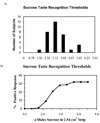A test for measuring gustatory function
- PMID: 18528309
- PMCID: PMC2823587
- DOI: 10.1097/MLG.0b013e31817709a0
A test for measuring gustatory function
Abstract
Objectives/hypothesis: The purpose of this study was to determine the usefulness of edible taste strips for measuring human gustatory function.
Study design: The physical properties of edible taste strips were examined to determine their potential for delivering threshold and suprathreshold amounts of taste stimuli to the oral cavity. Taste strips were then assayed by fluorescence to analyze the uniformity and distribution of bitter tastant in the strips. Finally, taste recognition thresholds for sweet taste were examined to determine whether or not taste strips could detect recognition thresholds that were equal to or better than those obtained from aqueous tests.
Methods: Edible strips were prepared from pullulan-hydroxypropyl methylcellulose solutions that were dried to a thin film. The maximal amount of a tastant that could be incorporated in a 2.54 cm2 taste strip was identified by including representative taste stimuli for each class of tastant (sweet, sour, salty, bitter, and umami) during strip formation. Distribution of the bitter tastant quinine hydrochloride in taste strips was assayed by fluorescence emission spectroscopy. The efficacy of taste strips for evaluating human gustatory function was examined by using a single series ascending method of limits protocol. Sucrose taste recognition threshold data from edible strips was then compared with results that were obtained from a standard "sip and spit" recognition threshold test.
Results: Edible films that formed from a pullulan-hydroxypropyl methylcellulose polymer mixture can be used to prepare clear, thin strips that have essentially no background taste and leave no physical presence after release of tastant. Edible taste strips could uniformly incorporate up to 5% of their composition as tastant. Taste recognition thresholds for sweet taste were over one order of magnitude lower with edible taste strips when compared with an aqueous taste test.
Conclusion: Edible taste strips are a highly sensitive method for examining taste recognition thresholds in humans. This new means of presenting taste stimuli should have widespread applications for examining human taste function in the laboratory, in the clinic, or at remote locations.
Figures



References
-
- Hawkes CH. Anatomy and Physiology of Taste Sense. Amsterdam: Butterworth Heinmeann; 2002. Smell and Taste Complaints; pp. 123–145.
-
- Perl E, Shufman E, Vas A, Luger S, Steiner JE. Taste- and odor-reactivity in heroin addicts. Isr J Psychiatry Relat Sci. 1997;34:290–299. - PubMed
-
- Driscoll KA, Perez M, Cukrowicz KC, Butler M, Joiner TE., Jr Associations of phenylthiocarbamide tasting to alcohol problems and family history of alcoholism differ by gender. Psychiatry Res. 2006;143:21–27. - PubMed
Publication types
MeSH terms
Substances
Grants and funding
LinkOut - more resources
Full Text Sources
Other Literature Sources
Miscellaneous

